I just received the news that Buchanan, at the Fine Arts Museums of San Francisco for the last six years, died yesterday at the age of 58.
Here’s a link to the press release.
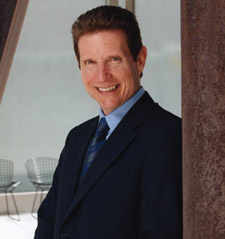 Previously, Buchanan had served as executive director of the Portland Art Museum in Portland, Oregon (1994-2005), director of Dixon Gallery and Gardens in Memphis, Tennessee (1986-1994) and executive director of the Lakeview Museum of Arts and Sciences in Peoria, Illinois (1982-1986).
Previously, Buchanan had served as executive director of the Portland Art Museum in Portland, Oregon (1994-2005), director of Dixon Gallery and Gardens in Memphis, Tennessee (1986-1994) and executive director of the Lakeview Museum of Arts and Sciences in Peoria, Illinois (1982-1986).
Buchanan was a controversial figure in the museum world, criticized for staging too many popular exhibitions in fashion, jewelry, Impressionism, etc., at the expense of scholarly exhibits that advanced ideas.
But by the numbers, he was a success.
As the press release notes:
Under Buchanan’s six-year stewardship the Museums welcomed over 11.9 million visitors, presented over 100 special exhibitions rooted in the depth and diversity of the museums’ permanent collections, oversaw the publication of 31 exhibition catalogues and collection-based publications, and increased the museums’ membership to 122,000 households. The Fine Arts Museums of San Francisco have the third largest membership in the nation, are the fourth most visited art museums in North America and are the fourteenth most visited museums in the world.
In its obit for Buchanan, the San Francisco Chronicle noted that Diane B. Wilsey, president of the museums’ board of trustees, had appointed a governance committee of seven of the top administrators as soon as Buchanan took medical leave in mid-December. It is headed by the CFO Michelle Gutierrez.
I knew John, and while he did have weaknesses as a museum director, he also had strengths. He threw his life and his enthusiasm into every museum he worked at. My sympathies go to his wife, Lucy.
Photo Credit: Courtesy of the Fine Arts Museums of San Francisco

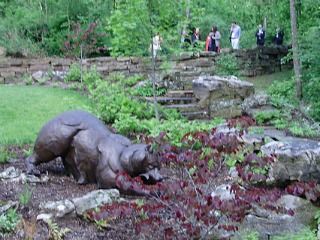 Noteworthy and, for the most part, laudable. Perhaps noting them will help counter the
Noteworthy and, for the most part, laudable. Perhaps noting them will help counter the 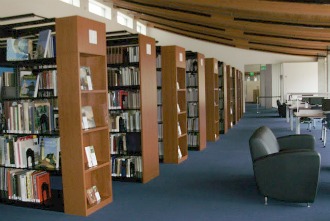 Next, the setting: Although I haven’t traversed all of the trails on the land surrounding the museum, I have on my two visits been able to walk some of them. They are lovely on their own, and while some large-scale sculptures sit on the premises (as above, Shore Lunch by Dan Ostermiller), they are sparse — so far — leaving plenty of room for nature. The building itself, which has several awkward features, does sit well in the ravine, relating to the terrain around it. Nice choice.
Next, the setting: Although I haven’t traversed all of the trails on the land surrounding the museum, I have on my two visits been able to walk some of them. They are lovely on their own, and while some large-scale sculptures sit on the premises (as above, Shore Lunch by Dan Ostermiller), they are sparse — so far — leaving plenty of room for nature. The building itself, which has several awkward features, does sit well in the ravine, relating to the terrain around it. Nice choice. And forget the uncomfortable furniture found in many libraries — Crystal Bridges offers comfortable chairs, desks and computers. Books and art periodicals have also been placed between galleries, allowing visitors to rest, to take a breather, in little lounges before taking in the next tranch of art.
And forget the uncomfortable furniture found in many libraries — Crystal Bridges offers comfortable chairs, desks and computers. Books and art periodicals have also been placed between galleries, allowing visitors to rest, to take a breather, in little lounges before taking in the next tranch of art.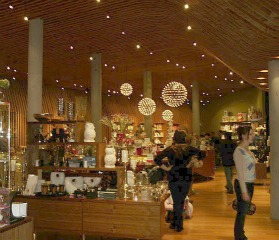 Crystal Bridges has a museum store — and a good one, very handsomely designed by Marlon Blackwell, as the photo at left attests –but it is not placed obnoxiously in front of the exit, so that all visitors must pass through it.
Crystal Bridges has a museum store — and a good one, very handsomely designed by Marlon Blackwell, as the photo at left attests –but it is not placed obnoxiously in front of the exit, so that all visitors must pass through it.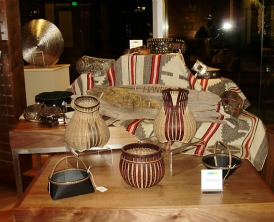 The museum also contains an auditorium, or, as it terms it, a “Great Hall” for lectures, concerts, films and other events — the one place I could not enter on either of my visits. It wasn’t finished last spring (there was only a hole in the ground then) and it was being set up for a concert when I visited in early December. The guard could not be persuaded to let me have a brief look.
The museum also contains an auditorium, or, as it terms it, a “Great Hall” for lectures, concerts, films and other events — the one place I could not enter on either of my visits. It wasn’t finished last spring (there was only a hole in the ground then) and it was being set up for a concert when I visited in early December. The guard could not be persuaded to let me have a brief look.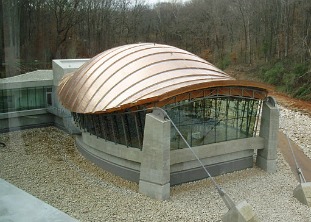 The hallway linking the main part of the museum to the Great Hall contains another admirable feature: the “community showcase.” Display cases have been inset in the walls, and area museums have been invited to place small displays drawn from their collections on view. This way, visitors to Crystal Bridges are exposed to other cultural institutions in the area, and they benefit from free publicity. Nice idea. The final photo, below, shows one of them currently on view. (Apologies for the poor picture quality. I was snapping during evening hours, which required a flash, and taking the pictures as museum visitors walked along the wall. I had to click fast.)
The hallway linking the main part of the museum to the Great Hall contains another admirable feature: the “community showcase.” Display cases have been inset in the walls, and area museums have been invited to place small displays drawn from their collections on view. This way, visitors to Crystal Bridges are exposed to other cultural institutions in the area, and they benefit from free publicity. Nice idea. The final photo, below, shows one of them currently on view. (Apologies for the poor picture quality. I was snapping during evening hours, which required a flash, and taking the pictures as museum visitors walked along the wall. I had to click fast.)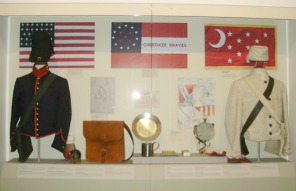 And did I mention the iPods? Visitors, upon surrender of a driver’s license or credit card, listen to guides about the collection on iPods, with Walton, museum director Don Bacigalupi and various curators providing commentary or dialogue for about two dozen works of art on view.
And did I mention the iPods? Visitors, upon surrender of a driver’s license or credit card, listen to guides about the collection on iPods, with Walton, museum director Don Bacigalupi and various curators providing commentary or dialogue for about two dozen works of art on view.![Hollan_2011_003[1].jpg](http://www.artsjournal.com/realcleararts/Hollan_2011_003%5B1%5D.jpg) When I visited Italy in November, I spent a day in Bologna, and among the places I visited was the
When I visited Italy in November, I spent a day in Bologna, and among the places I visited was the 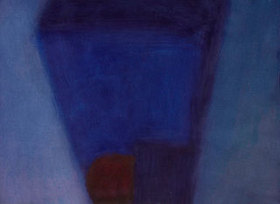 But the real revelation from my visit was not about Morandi. The museum regularly mounts temporary exhibitions for artists whose work relates to Morandi, and the exhibition I saw was for a wonderful artist I’ve never heard of: Alexandre Hollan.
But the real revelation from my visit was not about Morandi. The museum regularly mounts temporary exhibitions for artists whose work relates to Morandi, and the exhibition I saw was for a wonderful artist I’ve never heard of: Alexandre Hollan. 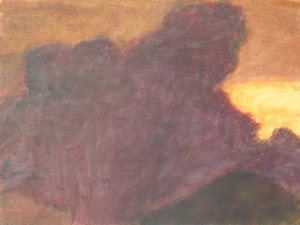 Hollan’s colors are every bit as subtle, but somehow are also richer. Many of the works are still lifes that overflow the boundaries of the paper, edging into the abstract. Mostly, he makes watercolors, gouaches, and drawings. The works on view, until Feb. 5, were made between 1984 and 2010.
Hollan’s colors are every bit as subtle, but somehow are also richer. Many of the works are still lifes that overflow the boundaries of the paper, edging into the abstract. Mostly, he makes watercolors, gouaches, and drawings. The works on view, until Feb. 5, were made between 1984 and 2010.![Hollan_2011_010[1].jpg](http://www.artsjournal.com/realcleararts/Hollan_2011_010%5B1%5D.jpg) Continuing my search, I found a few more online:
Continuing my search, I found a few more online: 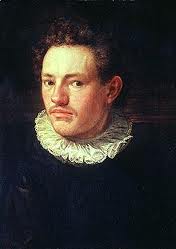 If a publication in the United States were awarding the “exhibition of the year” title, I’d bet the contenders would include the de Kooning exhibit at the Museum of Modern Art, the Alexander McQueen fashion show at the Metropolitan Museum, The Steins Collect at San Francisco MoMA, and … maybe Caravaggio at the Kimbell? The whole of “Pacific Standard Time” in LA?
If a publication in the United States were awarding the “exhibition of the year” title, I’d bet the contenders would include the de Kooning exhibit at the Museum of Modern Art, the Alexander McQueen fashion show at the Metropolitan Museum, The Steins Collect at San Francisco MoMA, and … maybe Caravaggio at the Kimbell? The whole of “Pacific Standard Time” in LA? 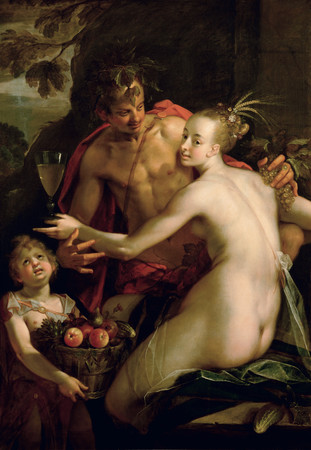 But there’s more to the artist (his Bacchus, Ceres and Amor is at left):
But there’s more to the artist (his Bacchus, Ceres and Amor is at left):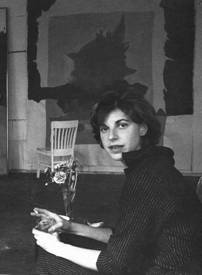 From a
From a